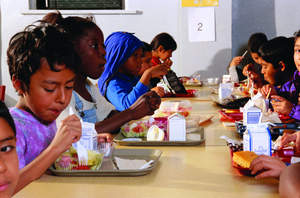MISSION, KS--(Marketwire - May 3, 2012) - (Family Features) As schools are hard at work revamping lunch menus in line with the U.S. Department of Agriculture's (USDA) new school lunch guidelines, chocolate milk has already undergone a makeover that schools, parents and kids can all feel good about.
Dr. Keith Ayoob, RD, a nationally-recognized child nutrition expert, highlights the biggest changes under the new guidelines:
More colorful fruits and vegetables. Both fruits and vegetables must be served every day of the week, and there is now a weekly requirement for specific colors of vegetables. Previously schools only had to offer either fruits or vegetables.
Whole grains will be required. While encouraged in the past, schools now must offer whole-grain rich foods. Schools are really looking at how to ensure foods are nutritious, but also appealing to kids. It's a challenge, but one that schools across the nation are focused on.
Schools are paying attention to portions. Calorie limits will be enforced based on the age of children being served to ensure proper portion size. New menus will be increasingly focused on reducing saturated fat, trans fats and sodium.
Nutrient-rich milk is emphasized. Along with low-fat and fat free white milk, now all the chocolate milk served for school lunch will be fat free.
While the school lunch menu has only recently changed, school chocolate milk has been undergoing changes for the past five years. The nation's milk processors have been hard at work to lower the calories and sugar in school flavored milk, while continuing to deliver a nutritious and delicious drink kids love. School flavored milk now has 38 percent less added sugar than just five years ago and on average, just 31 calories more than white milk. The majority have fewer than 150 calories per serving.
Flavored milk is the most popular choice in school lunch rooms, and kids drink less milk and get fewer nutrients when it's taken away. Whether flavored or white, milk has 9 essential nutrients, including calcium, vitamin D and potassium, which are all "nutrients of concern" that most kids fail to get enough of. Many kids are falling short of the recommended milk each day, and when they skip milk at lunch, they're not likely to make up for it the rest of their day.
Dr. Ayoob has some tips to help parents and kids make the most of school lunches:
- It's equally important that school meals are appealing, as they are nutritious. Along with good nutrition, food choices need to be practical, so they don't end up in the trash. Many children are overfed but undernourished, so focusing on our kids' nutrient intake is essential now more than ever. Studies show flavored milk contributes just 3 percent of added sugars to kids' diets, compared to sodas and fruit drinks, which account for close to half of the added sugar and deliver much less, if any, nutritional value.
- Help kids learn healthy choices. Research has found that if you offer kids carrots and celery, they'll eat more carrots than if you just provide carrots alone. Offering nutritious choices in schools helps kids learn food and nutrition lessons and research suggests the ability to choose between two or more options helps boost kids' overall intake of nutritious foods.
Learn more at www.milkatschools.com.
About Family Features Editorial Syndicate
This and other food and lifestyle content can be found at www.editors.familyfeatures.com. Family Features is a leading provider of free food and lifestyle content for use in print and online publications. Register with no obligation to access a variety of formatted and unformatted features, accompanying photos, and automatically updating Web content solutions.
Contact Information:
Wendy MacDonald
wmacdonald@familyfeatures.com
1-888-824-3337 ext. 235
http://editors.familyfeatures.com
